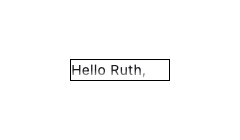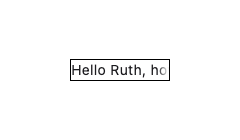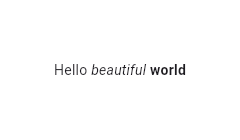Text class - widgets library (original) (raw)
A run of text with a single style.
The Text widget displays a string of text with single style. The string might break across multiple lines or might all be displayed on the same line depending on the layout constraints.
The style argument is optional. When omitted, the text will use the style from the closest enclosing DefaultTextStyle. If the given style'sTextStyle.inherit property is true (the default), the given style will be merged with the closest enclosing DefaultTextStyle. This merging behavior is useful, for example, to make the text bold while using the default font family and size.
Container(
width: 100,
decoration: BoxDecoration(border: Border.all()),
child: Text(overflow: TextOverflow.ellipsis, 'Hello $_name, how are you?'))Setting maxLines to 1 is not equivalent to disabling soft wrapping withsoftWrap. This is apparent when using TextOverflow.fade as the following examples show.

Here soft wrapping is enabled and the Text widget tries to wrap the words "how are you?" to a second line. This is prevented by the maxLines value of 1. The result is that a second line overflows and the fade appears in a horizontal direction at the bottom.

Here soft wrapping is disabled with softWrap: false and the Text widget attempts to display its text in a single unbroken line. The result is that the single line overflows and the fade appears in a vertical direction at the right.
Text(
overflow: TextOverflow.fade,
maxLines: 1,
'Hello $_name, how are you?')
// ...
Text(
overflow: TextOverflow.fade,
softWrap: false,
'Hello $_name, how are you?')Using the Text.rich constructor, the Text widget can display a paragraph with differently styled TextSpans. The sample that follows displays "Hello beautiful world" with different styles for each word.

const Text.rich(
TextSpan(
text: 'Hello', // default text style
children: <TextSpan>[
TextSpan(text: ' beautiful ', style: TextStyle(fontStyle: FontStyle.italic)),
TextSpan(text: 'world', style: TextStyle(fontWeight: FontWeight.bold)),
],
),
)Interactivity
To make Text react to touch events, wrap it in a GestureDetector widget with a GestureDetector.onTap handler.
In a Material Design application, consider using a TextButton instead, or if that isn't appropriate, at least using an InkWell instead ofGestureDetector.
To make sections of the text interactive, use RichText and specify aTapGestureRecognizer as the TextSpan.recognizer of the relevant part of the text.
Selection
Text is not selectable by default. To make a Text selectable, one can wrap a subtree with a SelectionArea widget. To exclude a part of a subtree under SelectionArea from selection, once can also wrap that part of the subtree with SelectionContainer.disabled.
This sample demonstrates how to disable selection for a Text under a SelectionArea.
To create a local project with this code sample, run:
flutter create --sample=widgets.Text.4 mysample
See also:
- RichText, which gives you more control over the text styles.
- DefaultTextStyle, which sets default styles for Text widgets.
- SelectableRegion, which provides an overview of the selection system.
Inheritance
Constructors
Text(String data, {Key? key, TextStyle? style, StrutStyle? strutStyle, TextAlign? textAlign, TextDirection? textDirection, Locale? locale, bool? softWrap, TextOverflow? overflow, @Deprecated('Use textScaler instead. ' 'Use of textScaleFactor was deprecated in preparation for the upcoming nonlinear text scaling support. ' 'This feature was deprecated after v3.12.0-2.0.pre.') double? textScaleFactor, TextScaler? textScaler, int? maxLines, String? semanticsLabel, String? semanticsIdentifier, TextWidthBasis? textWidthBasis, TextHeightBehavior? textHeightBehavior, Color? selectionColor})
Creates a text widget.
const
Text.rich(InlineSpan textSpan, {Key? key, TextStyle? style, StrutStyle? strutStyle, TextAlign? textAlign, TextDirection? textDirection, Locale? locale, bool? softWrap, TextOverflow? overflow, @Deprecated('Use textScaler instead. ' 'Use of textScaleFactor was deprecated in preparation for the upcoming nonlinear text scaling support. ' 'This feature was deprecated after v3.12.0-2.0.pre.') double? textScaleFactor, TextScaler? textScaler, int? maxLines, String? semanticsLabel, String? semanticsIdentifier, TextWidthBasis? textWidthBasis, TextHeightBehavior? textHeightBehavior, Color? selectionColor})
Creates a text widget with a InlineSpan.
const
Properties
The text to display.
final
The hash code for this object.
no setterinherited
Controls how one widget replaces another widget in the tree.
finalinherited
Used to select a font when the same Unicode character can be rendered differently, depending on the locale.
final
An optional maximum number of lines for the text to span, wrapping if necessary. If the text exceeds the given number of lines, it will be truncated according to overflow.
final
How visual overflow should be handled.
final
A representation of the runtime type of the object.
no setterinherited
The color to use when painting the selection.
final
A unique identifier for the semantics node for this widget.
final
An alternative semantics label for this text.
final
Whether the text should break at soft line breaks.
final
The strut style to use. Strut style defines the strut, which sets minimum vertical layout metrics.
final
If non-null, the style to use for this text.
final
How the text should be aligned horizontally.
final
textDirection → TextDirection?
The directionality of the text.
final
textHeightBehavior → TextHeightBehavior?
Defines how to apply TextStyle.height over and under text.
final
Deprecated. Will be removed in a future version of Flutter. UsetextScaler instead.
final
The font scaling strategy to use when laying out and rendering the text.
final
The text to display as a InlineSpan.
final
textWidthBasis → TextWidthBasis?
Defines how to measure the width of the rendered text.
final
Methods
build(BuildContext context)→ Widget
Describes the part of the user interface represented by this widget.
override
createElement()→ StatelessElement
Creates a StatelessElement to manage this widget's location in the tree.
inherited
debugDescribeChildren()→ List<DiagnosticsNode>
Returns a list of DiagnosticsNode objects describing this node's children.
inherited
debugFillProperties(DiagnosticPropertiesBuilder properties)→ void
Add additional properties associated with the node.
override
noSuchMethod(Invocation invocation)→ dynamic
Invoked when a nonexistent method or property is accessed.
inherited
toDiagnosticsNode({String? name, DiagnosticsTreeStyle? style})→ DiagnosticsNode
Returns a debug representation of the object that is used by debugging tools and by DiagnosticsNode.toStringDeep.
inherited
toString({DiagnosticLevel minLevel = DiagnosticLevel.info})→ String
A string representation of this object.
inherited
toStringDeep({String prefixLineOne = '', String? prefixOtherLines, DiagnosticLevel minLevel = DiagnosticLevel.debug, int wrapWidth = 65})→ String
Returns a string representation of this node and its descendants.
inherited
toStringShallow({String joiner = ', ', DiagnosticLevel minLevel = DiagnosticLevel.debug})→ String
Returns a one-line detailed description of the object.
inherited
A short, textual description of this widget.
inherited
Operators
operator ==(Object other)→ bool
The equality operator.
inherited